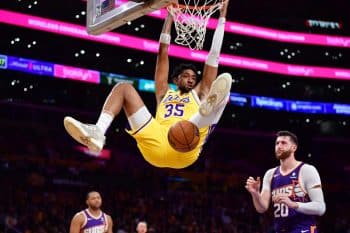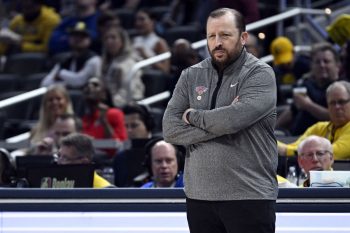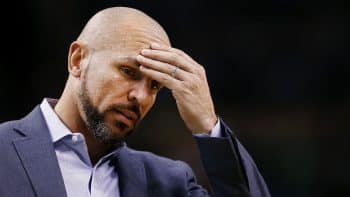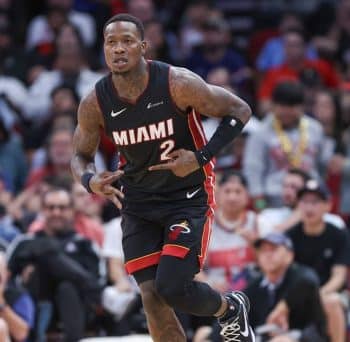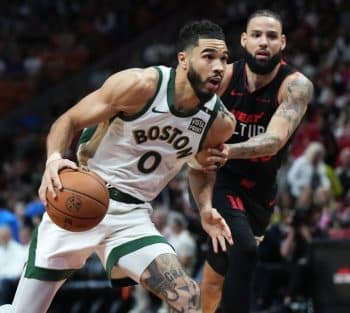NBA
NBA AM: One on One With Jahlil Okafor
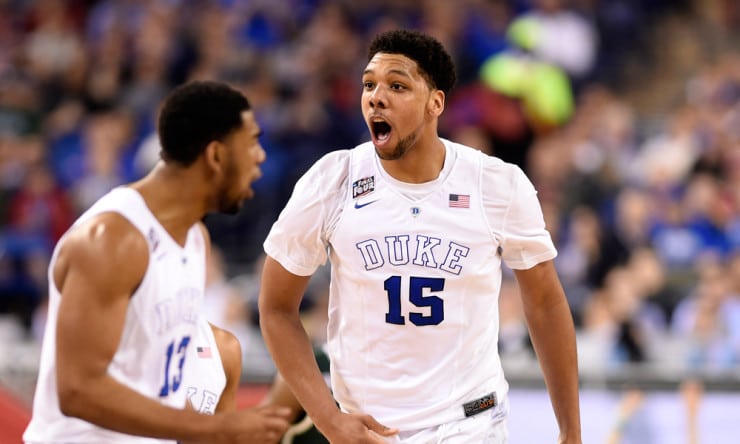
Okafor Ready to Play With the Pros
Back when Jahlil Okafor was a 17-year-old junior in high school, the big man told me that he believed he could compete in the NBA right then if given the opportunity. People in NBA circles loved his confidence and there were some talent evaluators who agreed with him.

To say that the last two months of Okafor’s life have been crazy is quite the understatement. In April, he achieved one of his childhood dreams when he led Duke to a national championship. He also earned many individual accolades, such as First-Team All-American honors and the ACC Player of the Year award (becoming the first freshman to win it). Then, he declared for the 2015 NBA Draft and, shortly after, started training three times a day at Peak Performance Project (P3) in California.
On June 25, Okafor will find out where he’ll be spending the next chapter of his life. Will he be the No. 1 overall pick to the Minnesota Timberwolves and play alongside the NBA’s reigning Rookie of the Year Andrew Wiggins? Will he go No. 2 overall to the Los Angeles Lakers and get the chance to learn from Kobe Bryant and join Julius Randle in their frontcourt?
He’s not sure, and he can’t wait for draft night so he can find out.
“I’m just ready,” Okafor told Basketball Insiders in a phone interview. “I’m excited about playing at the next level. I’m excited for the draft, and I’m really eager to see where I’m going to end up.”
In the meantime, Okafor continues to train at P3. Not only do their staffers do on-court training with the 19-year-old, they also put him through a customized workout designed to reduce the risk of injuries and maximize his potential and efficiency. P3’s staff includes biomechanists and data analysts, and each player who trains at P3 is assessed using state-of-the-art technology. Using the results from these evaluations, players are given specific “corrective exercises” to strengthen specific body parts that may have had a higher injury risk or could have potentially limited a player’s effectiveness on the court, as explained in-depth in a recent Sports Illustrated article. Going through this process, Okafor has learned a lot about his body and its strengths and weaknesses.
“It’s amazing; they give me all of these details, more than I’ve ever had, about my body and the way I move,” Okafor said of P3’s assessment. “They are able to pinpoint certain things that will help me move better and help me get certain [parts of my body] stronger and make me more explosive. I’m excited about it. It’s been a lot of fun and I’m going to continue to work with them.
“I’ve been staying out in Santa Barbara with pretty much all of the guys in my agency; we have a great group of guys who are all preparing for the draft. I’ve been out there with them and our workouts are at P3. I’m working on my explosiveness, my body, my agility and just a bunch of things. Those are some of the things I’ve been working on, and I’ve been working out three times a day. I’m just working as hard as I can to try to prepare myself for the next level.”
Okafor and Karl-Anthony Towns are considered the top prospects in this class, and many expect the big men to be the first two players picked on draft night. The question is, who goes first? When asked why he should be the No. 1 pick in the draft, Okafor had an interesting response. He says that he and Towns refuse to campaign to go first overall, either by talking themselves up or downplaying the talent of the other.
“I can’t say why I should be the number one overall pick,” Okafor said. “They try to have me and Karl debate with one another about why we should be number one, but we both thought the other should be number one. We have a lot of respect for each other.
“But if I’m talking to a team, any team, about why I should be picked, I’d say that I just want to win. That’s all I’m looking to do. That’s what I’ve done at every level and that’s all I want to do at the next level as well. That’s what I want to do. I want to be known as a winner, and I always have been. At the next level, I want that to continue.”
Reports have indicated that Towns won’t work out for teams, and Okafor confirmed that he has yet to schedule any workouts either. However, it does seem like he might work out for some teams before the draft, but he and his camp are still finalizing all of that.
“I don’t have anything scheduled yet, but I’m going to soon, obviously,” Okafor said. “Actually, I’m going to talk to my agent today and we’re going to figure that out. I know Karl isn’t working out for any teams and that’s definitely understandable, but me and my agent will talk about it today in detail and then I’ll have a better understanding of my schedule.” [Update: Okafor and his agent set his schedule and reports indicate his first workout will be with the L.A. Lakers on Tuesday.]
In his lone collegiate season at Duke, Okafor averaged 17.3 points, 8.5 rebounds and 1.4 blocks while shooting 66.4 percent from the field. He was the Blue Devils’ top option offensively, and he shot above 70 percent from the field in 20 games during his freshman year. NBA talent evaluators rave about his post moves, foot work, basketball IQ, court vision and touch around the basket. Most executives are in agreement that he is the best offensive big men to enter the NBA in years. Okafor made Duke’s offense unstoppable at times, with his ability to score and facilitate.
“Jahlil made the game so much easier for all of us,” Duke point guard Quinn Cook said. “Anytime we needed a bucket, we knew we could get the ball down to him and he’d score. When he was guarded one-on-one, 75 percent of the time he’d get a good shot up. When teams would double him, he’s one of the better passing big men so he’d find us. Either way, we’d always get a good shot because of him. That’s why we won the title – one of the big reasons. We could always go to him and he attracted so much attention from teams that the rest of us got to play freely because they were so worried about him. And at the next level, teams won’t be able to double him like that.”
What many people don’t see is the hard work that takes place behind the scenes to perfect the post moves and footwork that are so effective in games. Okafor began doing drills to improve these aspects of his game at 14 years old, as well as studying game film of Hakeem Olajuwon, Tim Duncan, Kareem Abdul-Jabbar and Patrick Ewing. Okafor is a workaholic with a desire to be great.
“It’s just always the way I’ve been because I love the game of basketball,” Okafor said. “I’ve just always wanted to be in the gym. That’s what I enjoy doing and that’s why I [work hard]. That’s just who I am. I’ve had some tragedies in my life and I’ve been able to rely on basketball [to cope with them]. The game has been great to me, and the only thing I know is to work hard.”
As he transitions to the NBA, one thing Okafor will be working hard to improve is his defense. Throughout this past season at Duke, Okafor was criticized for his defensive play and some have argued that Okafor’s poor play on that end of the court is why Towns should be Minnesota’s pick. Okafor is determined to silence the critics who say he can’t defend at a high level.
“I know I’m going to get better,” Okafor said of his defense. “I can get better at everything I do, and I always improve. I don’t think my defense was as bad as people made it out to be. We did win a national championship and all of my coaches were extremely happy with the way that I played on both ends of the floor. Also, I couldn’t get in to foul trouble and with the way our defense was set up, I wasn’t really in rim-protecting situations.
“Honestly, that is one of my flaws that I can improve on, but I can also improve on the offense end. Luckily, I’m 19 years old and I think I have a lot of time to improve my game. … I think a lot of people forget that a lot of us are still 18 or 19 years old. We’re put under the microscope and expected to be perfect, on the floor and sometimes even off the floor. Oftentimes, I do think people forget how young we actually are.”
As Okafor said, he often wasn’t asked to be a defensive stopper because his team needed him staying out of foul trouble and saving his energy to dominate on the offensive end. Duke assistant coach Jon Scheyer confirmed this. Scheyer said he did see defensive improvement from Okafor throughout the season, and added that he believes the intense criticism is mainly because Okafor has been projected to be the No. 1 pick in the 2015 NBA Draft for the last two years and people were looking to magnify the holes in his game.
“I think there are some who try to find flaws when a guy is averaging almost a double-double – averaging 19 and 9 for most of the year – there are always people who will try to find something [to criticize],” Scheyer said. “And, I mean, what are you going to say about him offensively? He averaged almost 20 points and he carried us at times. I think defense is what people tried to pick on, but what they don’t talk about is that there were games when Jahlil wasn’t just good, he was great on defense. Also, it’s very tiring when on offense you have a responsibility to score so much and carry the team at times, especially when guys were guarding him the way they were. But he’d still come down on defense and be involved in pick-and-roll defense and guard the basket. We asked a lot, and he did a great job battling through everything and getting better as the season went on.
“I saw a lot of improvement from Jahlil throughout the season. Obviously, he came in with a ton of talent and all kinds of offensive gifts, no question, but I thought on the defensive end he made huge strides. When you look at his ball coverage and protecting the basket, I think he got better and better at that. And, look, people were beating on him. If you look throughout our season, he took a beating and opponents were fouling him on almost every play. Just being able to fight through that [was impressive], and I definitely think he got better as the season went on.”
Cook also defended Okafor, shooting down the criticism.
“He’s 19, he was only a freshman!” Cook said. “He has a lot of room to get better, and he knows that, which is why he’s always in the gym working out and trying to improve. In the tournament, I think he played his best defensively. We were defending together a lot of the time and he was always active and he never let guys get by him. He played great defensively during the tournament, so he got better on that end throughout the year and he’ll only continue to get better.”
Scheyer’s point about Okafor being overly criticized due to his top ranking is interesting, as Andrew Wiggins experienced the same thing in his lone college season at Kansas before thriving in the NBA this year. Towns hasn’t faced nearly as much scrutiny, despite the fact that he didn’t show he can be a top option on offense like Okafor did, had a much smaller sample size at Kentucky (averaging 10 fewer minutes per game than Okafor) and had some problems with foul trouble (fouling out of six games to Okafor’s zero even while playing significantly less). However, with Towns, there’s little talk of these issues and much more focus on his potential and strengths.
Among fans, there seems to be this perception that Towns is by far the better prospect, but many executives disagree. While it’s true there are plenty of executives who are Team Towns, there are many who are Team Okafor and who believe he’s the better prospect. However, in talking to executives, one thing becomes clear: Most believe both players will be extremely successful and productive, just in different ways.
Okafor is very mature for his age, so he has accepted that he will always have to deal with criticism regardless of what he does. This is often difficult for young players to grasp, but Okafor’s time as the nation’s top high school recruit and top collegiate player helped him come to this realization.
“Honestly, I’ve been that top guy that everyone looked at for most of my high school career and going to college that didn’t change, so [you’re under the microscope],” Okafor said. “It’s something that I’ve come to expect. Me and my dad were just talking about how LeBron James and Stephen Curry and all of those guys get criticized, and I’m not nearly as good as they are, so I wouldn’t expect anything else.”
Okafor’s season at Duke was clearly a success, as he was able to add a national championship to his long list of accomplishments and position himself to be a top pick in the draft.
“My year at Duke was amazing, obviously, and I think I improved tremendously being under Coach K and playing with guys like Tyus [Jones] and Justise [Winslow] and Quinn Cook and the guys who were already there,” Okafor said. “I really improved by seeing how hard they worked and taking little things from each of those guys. And learning from Coach K, that’s just a whole ‘nother ball game. He definitely made me a better player. I loved watching film with him after practice to see things that I could improve on. From a basketball standpoint, that’s the most I ever improved over a one-year period.”
However, he still feels like there are aspects of his game that he didn’t get to showcase at Duke. For example, Okafor rarely took jump shots in college, simply because it made more sense for him to score over inferior centers in the paint since he shot such a high percentage there. When you’re unstoppable in the paint, why venture outside of it? But that doesn’t mean he can’t knock down jumpers. He’s excited to showcase some of his other talents in the NBA and continue expanding his game even more.
“I’d like to say that there is a lot more that I can do,” Okafor said. “There are things that I can improve on, but there are a lot of things that I’m going to do at the next level that a lot of people haven’t seen. I do believe there are a lot of other things that I’m capable of doing and that I have done [in the past]. At Duke, I didn’t need to shoot jump shots and that wasn’t my role.”
“I think Jahlil is going to be a really, really good 15-to-18-foot shooter; I think he’ll really be able to shoot those well, especially as he develops over the next few years in the NBA,” Scheyer added. “He has a great touch and I think that can be expanded all the way out there. Another thing, he’s a great passer. He has a great feel for the game and while I think you got to see a glimpse of it this year, I think it’s harder to double-team in the NBA and you’ll be able to see his passing ability even more at the next level.”
“There’s more he can do,” Cook said. “There were games, like at Wisconsin, where he hit two face-up jumpers. One of them was off of the glass. There were games, like against North Carolina, where he was dribbling to the rack and doing a lot.”
After spending a year with Okafor, Scheyer and Cook expect him to dominate in the NBA.
“I think he’s going to be very special and he’s going to be a franchise player for one city for 15 years – I think that’s the type of player he should be,” Scheyer said. “I think the sky is the limit for Jahlil. In college, he got double-teamed so much, but in the NBA I don’t think he’ll see that as much. He’ll have some great defenders guarding him, but once he adjusts to that, the sky is the limit for him.”
“He’s going to be a franchise player,” Cook said. “He has a great feel for the game and a real love for the game, plus he’s so humble.”
Okafor has been compared to a young Tim Duncan by many people (including Duncan’s former teammate David Robinson), and Scheyer believes the comparison makes sense.
“Tim Duncan, I think, is probably the best power forward of all-time so to draw comparisons to him is obviously a huge, incredible compliment, but I do think Jahlil has some similarities to him,” Scheyer said. “Mainly, I think it’s just the feel for the game that both of them have. You can’t teach what Jahlil has. His touch around the basket is unlike anything I’ve ever seen from a player I’ve been around. There isn’t anyone else like Jahlil. So from that standpoint, I think it’s a very good comparison.”
In case you didn’t know, expectations are extremely high for Okafor as he enters the NBA. But that’s nothing new for Okafor. In high school, people expected dominance and he delivered with ridiculous stats, multiple national player of the year awards and an IHSA championship. In college, he was expected to be one of the best players in the country and he lived up to the hype and brought a championship to Duke.
In the NBA, he’ll be expected to become a franchise-changing star who can eventually lead his team to a title (adding another kind of championship to his résumé). As Okafor said, he’s ready.
